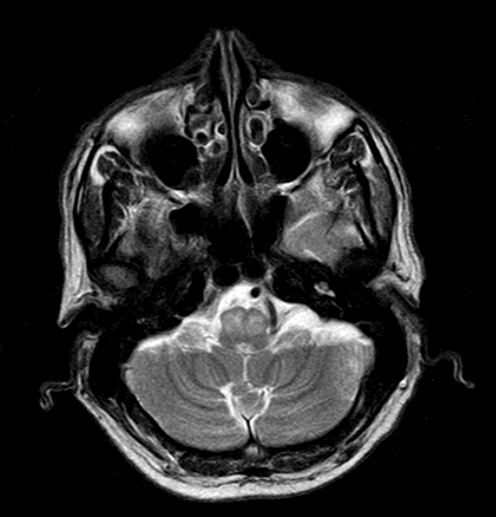Category: Ataxia
Objective: To describe a patient with Progressive Ataxia with Palatal Tremor (PAPT) syndrome due to Idiopathic Bilateral Hypertrophic Olivary Degeneration
Background: Hypertrophic olivary degeneration (HOD) is an unusual form of trans-synaptic degeneration characterized by hypertrophy of the inferior olivary nucleus (ION) situated in the upper part of the medulla oblongata. (1) It results from focal lesions disrupting the connections from the inferior olive within the dentato-rubro-olivary pathway (DROP), a region also known as the Guillain-Mollaret triangle (GMT). Only 154 cases published in the literature so far. HOD is usually secondary and unilateral. Here we present a case of Idiopathic Bilateral HOD.
Method: Not applicable
Results: A 52-year-old male, without prior comorbidities, presented with complaints of ataxia and dysarthria for past 1 year. On examination, patient had a palatal tremor and cerebellar signs. Patient was clinically diagnosed with Progressive Ataxia with Palatal Tremor (PAPT) syndrome. The familial and sporadic causes of PAPT syndrome were considered. MRI Brain revealed bulky olivary nucleus bilaterally and T2/FLAIR hyperintense. (Figure – 1) Bilateral HOD is very rare. The two causes described in the literature are Anti-NMDA encephalitis and Chronic lymphocytic inflammation with pontine perivascular enhancement responsive to steroids (CLIPPERS). POLG and SURF mutations have also been described as a cause of bilateral HOD. Since the CSF study was normal, Anti-NMDA encephalitis and CLIPPERS were ruled out. Genetic analysis ruled out the mutations associated with HOD. Since the secondary causes were considerably ruled out, the patient was diagnosed with Bilateral Idiopathic Olivary degeneration. Our patient was treated with memantine and gabapentin. Patient clinically improved.
Conclusion: HOD is usually described in the context of secondary cause. Idiopathic HOD is very rare. The MRI findings in a case of HOD may be variable. Hence HOD should be suspected in patient with PAPT syndrome regardless of the MRI findings.
References: 1. Wang H, Wang Y, Wang R, Li Y, Wang P, Li J, Du J. Hypertrophic olivary degeneration: A comprehensive review focusing on etiology. Brain Res. 2019 Sep 1;1718:53-63.
To cite this abstract in AMA style:
D. E, S. Kumar, A. Antony, J. Kumar. A case of progressive ataxia with palatal tremor (PAPT) syndrome due to idiopathic bilateral hypertrophic olivary degeneration [abstract]. Mov Disord. 2023; 38 (suppl 1). https://www.mdsabstracts.org/abstract/a-case-of-progressive-ataxia-with-palatal-tremor-papt-syndrome-due-to-idiopathic-bilateral-hypertrophic-olivary-degeneration/. Accessed April 1, 2025.« Back to 2023 International Congress
MDS Abstracts - https://www.mdsabstracts.org/abstract/a-case-of-progressive-ataxia-with-palatal-tremor-papt-syndrome-due-to-idiopathic-bilateral-hypertrophic-olivary-degeneration/

